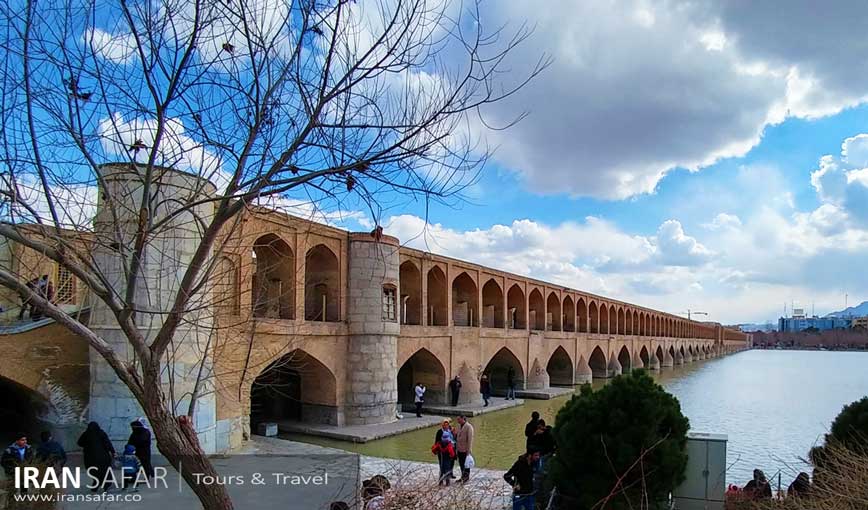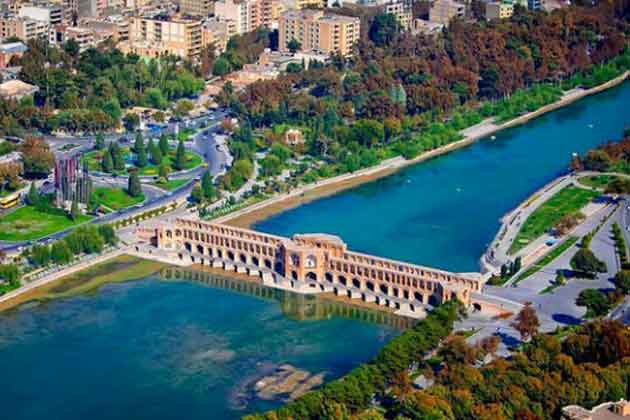Zayandeh rud also spelled as Zayanderud (meaning Life-giving river in Persian), is the largest river of the Iranian Plateau in central Iran that originates from mount Zard-kuh in the Zagros mountains in Chaharmahal & Bakhtiari province, and flows east in the central plain of Iran until finally flows into the Gavkhouni Wetland.
Geography of Zayandeh Rud
The river of Zayandeh rood originates in the mount Zardkuh in Chaharmahal & Bakhtiari Province. It flows 400 km (249 mi) eastward before ending in the Gavkhouni marshlands, southeast of Isfahan city.
Zayandeh Rood river basin is 41,500 square kilometers. It is estimated that the water flow of this river in the most favorable conditions is 1.2 cubic kilometers per year or 38 cubic meters per second.
It used to give life to the people of central Iran mainly in Isfahan and Yazd provinces before the drying-out …
Zayandeh rood is the 118th natural monument that was registered in the list of natural heritage of Iran by the Iranaian Cultural Heritage Organization on February 11, 2011.

Why Zayendeh Rud is Dry Now?
Unlike many of Iran rivers which are seasonal, Zayandeh Rud used to have significant flow all year long, but today runs dry due to water extraction before reaching the city of Isfahan. In the early 2010s, the lower reaches of the river dried out completely after several years of seasonal dry-outs.
History of Zayandeh Rud
Man has continuously lived on the banks of Zayandeh Rood River for thousands of years. The earliest evidence of human life along this river was found in a cave site called Qaleh Bozi at south west of Isfahan. More than 40,000 years ago, groups of Paleolithic hunters (Neanderthals) used these caves as shelters for seasonal or temporary occupations and left their stone tools and bones of hunted animals.
Suitable climate has been one of the initial conditions for the formation of civilizations and their continuation throughout history. Relevant fertile rivers and plains have also been one of the production bases of civilizations
Historically, the oldest known archaeological site along this river are two caves and a stone shelter located 30 km south of Isfahan, which was identified in 2005 and since then three periods of archaeological excavations have been carried out in this place.
Based on the findings, including a variety of stone tools, as well as dating with carbon 14, these caves date back to the Middle Paleolithic period of 40,000 to 60,000 years ago. This ancient site, which is the oldest known ancient site in the Central Plateau so far, is locally located on a mountain called Qalae Bozi Mountain, through which the Zayandeh River passes. Based on the bone samples obtained, it is obvious that the river has provided very favorable conditions for the formation of this settlement.
In the 17th century, Shaikh Bahai (an influential scholar and adviser to the Safavid dynasty), designed and constructed a system of city canals (Maadi), to distribute the river’s water to Isfahan’s suburbs. Water from the Zayandeh River helped the growth of the population and the economy in a city in the middle of a desert and helped Isfahan become an amazing city with a green landscape.
Also Read: Naqsh-e Jahan Square
Bridges on Zayandeh Rud
The Zayandeh river bed is spanned by many historical Safavid era bridges and some newly-built ones, and the river used to flow through many parks. The oldest, Shahrestan bridge, built in the 5th century AD, is still in use as a pedestrian crossing in Sharestan village.
American archaeologists and historians of Persian art, Arthur Upham Pope and his wife Phyllis Ackerman are buried in a small mausoleum on the river bank. Richard N. Frye (an American scholar of Iranian and Central Asian Studies) has also requested to be buried there.
Si-o-Se Pol Bridge
The most famous bridge in Isfahan is Si-o-Se pol (also called Allah Verdi Khan Bridge) that connects the north of Chahâr Bâgh avenue to the south, the main artery of Isfahan and then to the Armenian district of Julfa.
Built in 1602, this beautiful and attractive bridge still retains its beauty and stability after about 400 years. It is so attractive and spectacular in terms of architecture that every viewer stares at it for hours and watches its glory on the Zayandeh River. This bridge is 295 meters long and 14 meters wide. This bridge has 33 base arches and its construction dates back to the time of Shah Abbas I Safavid, which was built by a famous commander Allah Verdi Khan.
Khajou Bridge
Khaju Bridge, built in 1650 and restored in 1873, is one of the historical bridges on the Zayanderud in Isfahan. linking the Khaju quarter on the north bank to the Zoroastrian quarter across the Zayanderud. The bridge was used a place for public meetings as well. There is a pavilion located in the center of the structure, inside which Abbas II would have once sat, admiring the view.
The mausoleum of Arthur Pope and his wife Phyllis Ackerman is situated nearby.
Shahrestan Bridge
One of the famous and old bridges built on Zayandeh Rud River in Isfahan is Shahrestan Bridge. Also known as Jey, the bridge is one of the oldest bridges in Iran.
In fact, Shahrestan bridge was built during the rule of Sasanian Empire and is the oldest bridge built on the Zayandeh River. But apparently its foundations belong to the Achaemenid era. On the bridge, there are traces of the Deylamian and Seljuk periods (apps. 1000 years ago), which indicate that the bridge was restored during these periods.
Other bridges:
- Marnan Bridge Built in 1599 (pedestrian)
- Vahid Bridge Built in 1976
- Vahid Bridge II Built in 2007
- Felezi Bridge Built in the 1950s
- Azar Bridge Built in 1976
- Ferdosi Bridge Built in the 1980s
Zayandeh Rud Dam
Zayandeh Rud Dam is one of the sights of Chadegan city, 125 km west of Isfahan and 50 km north of Shahrekord city.
Formerly known as the Shah Abbas Dam, it was built in 1960 in order to supply drinking water to the provinces of Isfahan, Yazd and some other neighboring provinces. It produces 250 million kilowatt-hours of hydroelectric energy annually, controls seasonal floods and regulate the agricultural water needed for 100 thousand hectares of agricultural land. It was built downstream on the Zayandeh River.



Comment (0)